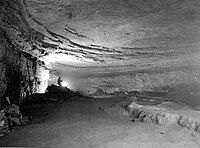
A Multiparametric Approach for Evaluating the Current Carbonate Precipitation and External Soil of Nerja Cave (Málaga, Spain)
Sign Up to like & getrecommendations! Published in 2020 at "International Journal of Environmental Research"
DOI: 10.1007/s41742-020-00278-x
Abstract: The soil above on a cave may act as a regulator of the changes occurring in and on the cavity, modifying water infiltration and retention and providing organic matter, clay minerals, and nutrient elements, all… read more here.
Keywords: precipitation; nerja cave; soil; drip water ... See more keywords

U-series dating at Nerja cave reveal open system. Questioning the Neanderthal origin of Spanish rock art
Sign Up to like & getrecommendations! Published in 2020 at "Journal of Archaeological Science"
DOI: 10.1016/j.jas.2020.105120
Abstract: Abstract U/Th data obtained on CaCO3 layers covering rock art at Nerja Cave (Spain) evidence erroneous ages and an inverse relation between uranium concentration and apparent ages. This open system behavior could be due to… read more here.
Keywords: nerja cave; open system; rock art; art ... See more keywords

New perspectives for 14C dating of parietal markings using CaCO3 thin layers: An example in Nerja cave (Spain)
Sign Up to like & getrecommendations! Published in 2017 at "Journal of Archaeological Science: Reports"
DOI: 10.1016/j.jasrep.2017.01.028
Abstract: For the first time direct 14C dating was undertaken on two black parietal marks in Nerja cave (Malaga province, Southern Spain). Analyses were conducted on charcoal splinters (conifer wood) from the marks but also on… read more here.
Keywords: new perspectives; perspectives 14c; 14c dating; nerja cave ... See more keywords

Multianalytical and multiproxy approach to the characterization of a Paleolithic lamp. An example in Nerja cave (Southern Iberian Peninsula)
Sign Up to like & getrecommendations! Published in 2019 at "Journal of Archaeological Science: Reports"
DOI: 10.1016/j.jasrep.2019.102021
Abstract: Abstract Understanding the illumination systems used by Paleolithic groups in caves gives us essential information about the Paleo-speleological capabilities of our ancestors and their activities in dark spaces. In this paper, we present a multianalytical… read more here.
Keywords: multiproxy approach; multianalytical multiproxy; approach characterization; paleolithic lamp ... See more keywords

Biological Control of Phototrophic Biofilms in a Show Cave: The Case of Nerja Cave
Sign Up to like & getrecommendations! Published in 2020 at "Applied Sciences"
DOI: 10.3390/app10103448
Abstract: Cyanobacteria and microalgae are usually found in speleothems, rocks and walls of show caves exposed to artificial lighting. These microorganisms develop as biofilms coating the mineral surfaces and producing aesthetic, physical and chemical deterioration. A… read more here.
Keywords: nerja cave; biofilms show; biological control; control phototrophic ... See more keywords